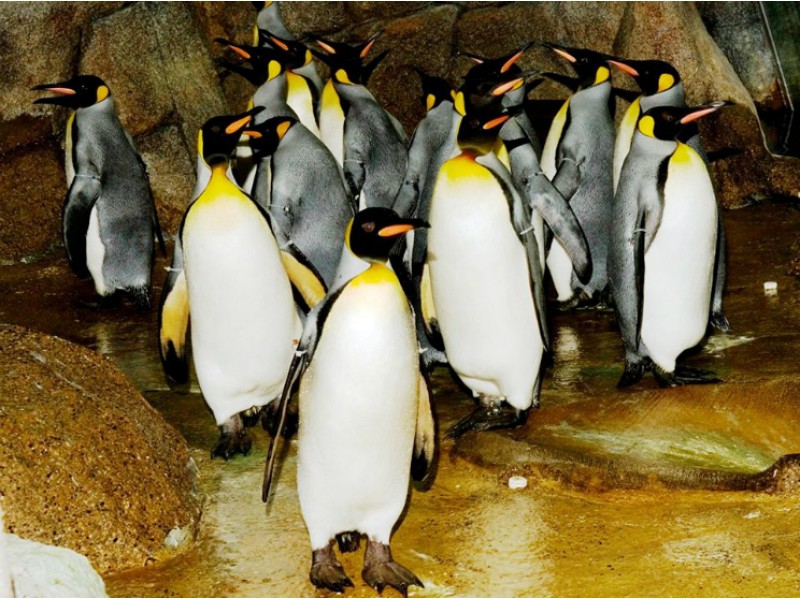New Polk Penguin Conservation Center expected to bring visitors from around the world to Royal Oak and surrounding area.
Royal Oak, MI

The silhouette of an enormous tabular iceberg juts out on each end, with giant beams of steel forming what will soon be a breathtaking sight — the Polk Penguin Conservation Center at the Detroit Zoo.
The new 33,000-square-foot facility — the largest penguin facility in the world — is expected to open in early 2016, according to a news release. Construction began 15 months ago.
The Polk Penguin Conservation Center will be home to more than 80 penguins representing four species — gentoo, macaroni, rockhopper and king.
“An incredible amount of research has gone into the development of the Polk Penguin Conservation Center’s unique and authentic design, including us actually crossing the Drake Passage to Antarctica and observing thousands of penguins in the wild,” said Detroit Zoological Society Executive Director and CEO Ron Kagan said.
“This will be the most extraordinary conservation center for penguins in the world and will redefine ‘state of the art’ for penguin habitats, just as our Penguinarium did in 1968,” Kagan said. “People will come from all over the world to see this amazing facility.”
The design of the facility was inspired by the harsh and visceral ice world of Antarctica and its history. The facility’s dramatic exterior resembles a tabular iceberg, complete with a crevasse and waterfall.
Sir Ernest Shackleton’s legendary Antarctic expeditions and epic crossings of the Drake Passage influenced what will be a dramatic entry experience. Visitors will descend a series of ramps as they are surrounded by 4-D effects, including arctic blasts, waves, snow and iceberg “calving” — a phenomenon where icebergs split, sending massive cascades of ice crashing into the sea.
One of the most dramatic features of the penguin habitat promises to be a chilled, 326,000-gallon, 25-foot-deep aquatic area where visitors will be able to watch penguins as they explore their habitat and deep-dive — something that is otherwise impossible to see, even in the wild.
Two acrylic underwater tunnels — similar to those in the Detroit Zoo’s award-winning Arctic Ring of Life — will offer views overhead and below as the birds swim, dive and soar.
In early 2015, three gentoo penguins made their debut, setting the stage for many more of their species to come. The gentoo is the third-largest penguin and — like the macaroni, rockhopper and king — is native to extremely cold-weather climates. More gentoos are due to arrive in the coming months as completion of the Penguin Conservation Center nears.
While providing for a spectacular visitor experience, the animal habitat itself will ensure an optimal environment for the welfare of the penguins — with the air temperature set to a near-freezing 37 degrees Fahrenheit — and is designed to encourage wild behavior, from diving and porpoising to nesting and rearing young.
The Penguin Conservation Center was planned with many water- and energy-saving features, consistent with the zoo’s commitment to environmental leadership.
The building has net-zero water goals through the recirculation and treatment of the habitat and animal-management pools, wash-down systems and exterior splash-play area.
Additionally, the facility was designed with a super-insulated exterior building envelope and will be equipped with state-of-the-art custom heating and cooling systems to minimize energy consumption.
The zoo recently was honored with the 2015 Green Award by the Association of Zoos & Aquariums (AZA) in recognition of these and other green efforts under the organization’s Greenprint, a strategic plan to ensure that daily practices and policies along with facility design at the Detroit Zoo and Belle Isle Nature Zoo are implemented in the most energy-efficient and sustainable manner.
The award recognizes green programs that exist institution-wide in the 230 AZA-accredited zoos and aquariums to reduce the environmental impact of an organization from a business operations standpoint.
The Detroit Zoological Society also supports penguin conservation programs around the world, including providing funding for the Polar Oceans Research Group, led by world-renowned polar ecologist and penguin expert Dr. Bill Fraser, who consulted in the design of the Penguin Conservation Center.
When complete, the facility will provide a forum to engage Detroit Zoo visitors in these programs, to educate them on the threats that penguins face across the southern hemisphere, and to even meet some of the scientists working with penguins in the wild.
After the penguins move into the Penguin Conservation Center, work will begin to transform their current home, the Penguinarium, into a Bat Conservation Center.
» Photo via Detroit Zoo
source

















No comments:
Post a Comment